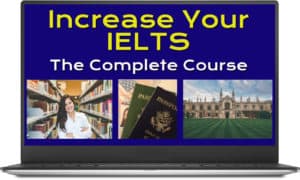IELTS Writing Task 2 Question Types
There are several different types of essay questions that you may face on exam day. Being able to to identify the question type means you will be able to select an appropriate essay structure to write your essay with.
Watch the video or read the notes beneath for a full explanation.
Essay Structures
An 'essay structure' basically means what you are going to write in each of your paragraphs and in what order. Getting this correct makes your essay logical and understandable.
IELTS examiners call this 'coherence and cohesion' and it is one of the four criteria they use to grade your essay. That is why identifying the question type is so important.

The Different Question Types
In the diagram above you can clearly see the four different question types and what you need to write in each paragraph to ensure a well structured essay.
Some teachers break the question type down even further into 6, 7 or even 8 question types. I prefer to keep it as simple as possible which means less to remember and less stress in the exams.
The other question types you might read about are as follows:
Direct question, or two part questions. I consider these to be 'Discussion' type questions and use that structure.
Question asking about advantages/disadvantages. I consider these to be 'Discussion' question types, or 'Discussion and Opinion' question types depending on whether they ask for your opinion or not.
Problem and solution, or cause and effect questions, I group as 'Situation' question types.
Within the paragraph structures I have shown you above there is a lot of room for flexibility in what you write, which means all question types can be covered by these. The main thing to consider is whether you are actually addressing all parts of the question logically within your paragraphs.
How To Identify The Different Question Types
To what extent do you agree or disagree?
Is this a positive or negative development?
What is your opinion?
Discuss both sides.
What are the benefits and drawbacks?
Discuss the advantages and disadvantages.
What are the advantages and disadvantages of this?
Discuss both sides and give your opinion.
Do the advantages outweigh the disadvantages?
What are the problems? What solutions can you suggest?
Which factors contribute to this? What problems does this create?
What are the causes of this? How can this problem be solved?
How does this effect…? How can this situation be solved?
Why is…? Should the…?
Why is…? How can…?
Do you think…? Should…?
Now, you have worked out what type of essay question you have, the next step is to generate your ideas and plan your answer.
IELTS Writing Task 1 (Academic)
Discover how to describe all types of visual data that you may see in this part of the test.
Sshhhhh! Listen closely, here are some valuable tips, techniques and strategies for maximising your listening band score.
IELTS Writing Task 1 (General)
Discover how to write in the correct format and tone for this part of the test.
Learn 'what' to say and 'how' to say it in each part of the test to impress the examiner.






